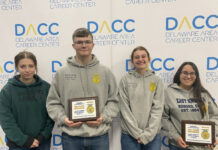
This morning I woke up and thought about what I’d write about for this edition of the Farm and Dairy. I remembered the title of the column being “Dirt on Conservation.”
In this column, I’ve seen a wide range of conservation-based topics from wildlife conservation pertaining to habitat modifications and full-blown restoration projects to preserve some of our natural landscapes to talking about the micro-biology of our soil structure and all of the nitty-gritty parts that go into it. It made me think about all the things that truly revolve around soil.
Now, as a district technician for a soil and water office, we talk to plenty of people in the community about what soil truly is. I have to chuckle when I see the Dirt on Conservation article and think about the example that I give people.
Dirt is what you track through the house from outside while soil is the medium that all living things need to grow. Soil is essentially the base of our existence. Without soil, our plants that provide oxygen for us to breathe wouldn’t be able to survive.
As many folks that might pick up a Farm and Dairy newspaper, I’m sure the vast majority of us know that soil health is one of the more important components to making sure that our crops have a fighting chance. Ensuring that the ground that we rely on is in the best shape that we can possibly have it in should be at the top of every farmer’s to-do list. Unfortunately, due to some of our previous farming practices, some of our agriculture ground is not in the best shape. With the adoption of newer research and slightly adjusted mindsets of farming, we’ve been able to take some steps in the right direction when it comes to taking care of our soil.
No-till
Starting out with no-till farming from conventional till may be a task in itself. After all, changing a farming practice that has been so widely used and accepted for many years may appear to be risky to some. Now, there are some short-term benefits to tilling the ground.
Tillage actually adds oxygen to the soil to help break down organic materials and add nutrients, but continuous tillage burns out the soil ecosystem in the long-term. The more we disrupt the soil, the more we disrupt the ecosystem in our soil.
No-till farming alone is good for soil conservation because it doesn’t disturb the soil’s surface by tillage and making it highly susceptible to erosion potential. In a well-managed no-till system, you will spend less time in the field with equipment. Not having to do multiple passes on the field prevents soil compaction. Having a crop residue on the soil surface to decompose allows for soil organic matter to build up.
Cover crops
Cover crops are plants that are grown to cover the soil after a cash crop has been harvested. Oftentimes, this cover crop will remain on the field through the winter and spring months, until it’s time to plant again. This cover protects the soil from erosion, helps to control soil temperature and moisture too.
The presence of a living root system during a time that generally wouldn’t have growth in an agriculture system is crucial. These roots are breaking up soil compaction and recycling nutrients back into the soil that may have been depleted by the previous crop.
Cover crops and no-till farm practices mimic natural vegetative cycles. Having a field that goes through similar processes as a natural system has the opportunity to be more sustainable, efficient and profitable.
When I think about the name Dirt on Conservation and think about what our goal as a soil and water conservation district is, it all comes back to conserving our natural resources. The base of our entire natural world is our soils and the quality of our natural world is dependent on the quality of our soil.
Just as Dr. Seuss depicted “The Lorax,” our favorite speaker for the trees, the soil can use a spokesperson as well. “Unless someone like you cares a whole awful lot, nothing is going to get better. It’s not.”












